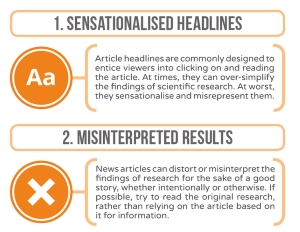References (Chapter 10)
< Back to search results- Difficulty Introductory
Details
References for “Research – good, bad, and unnecessary”:
1 Equator network resource centre for good reporting of health research studies: accessed 17th January 2012.
2 European Carotid Surgery Trialists’ Collaborative Group. Randomised trial of endarterectomy for recently symptomatic carotid stenosis: final results of the MRC European Carotid Surgery Trial (ECST). Lancet 1998;351:1379-87.
3 Cina CS, Clase CM, Haynes RB. Carotid endarterectomy for symptomatic carotid stenosis. The Cochrane Database of Systematic Reviews 1999, Issue 3. Art. No.: CD001081. QUERY – Link goes to the 2011 update of this review.
4 The Magpie Trial Collaborative Group. Do women with pre-eclampsia, and their babies, benefit from magnesium sulphate? The Magpie Trial: a randomised, placebo-controlled trial. Lancet 2002;359:1877-90.
5 Duley L, Gülmezoglu AM, Henderson-Smart DJ. Magnesium sulphate and other anticonvulsants for women with pre-eclampsia. Cochrane Database of Systematic Reviews 2003, Issue 2. Art. No.: CD000025.
6 Global Report. UNAIDS report on the Global AIDS epidemic 2010: accessed 17th January 2012.
7 Grimwade K, Swingler G. Cotrimoxazole prophylaxis for opportunistic infections in adults with HIV. Cochrane Database of Systematic Reviews 2003, Issue 3. Art. No.: CD003108.
8 Chintu C, Bhat GJ, Walker AS, et al. Co-trimoxazole as prophylaxis against opportunistic infections in HIV-infected Zambian children (CHAP): a double blind randomised placebo-controlled trial. Lancet 2004;364:1865-71.
9 MRC News Release. Antibiotic drug almost halves AIDS-related death in children. London: MRC, 19 November 2004.
10 World Health Organization and UNICEF. Co-trimoxazole prophylaxis for HIV-exposed and HIV-infected infants and children: practical approaches to implementation and scale up. WHO and UNICEF, 2009.
11 Soares K, McGrath J, Adams C. Evidence and tardive dyskinesia. Lancet 1996;347:1696-7.
12 Thornley B, Adams C. Content and quality of 2000 controlled trials in schizophrenia over 50 years. BMJ 1998;317:1181-4.
13 Howell CJ, Chalmers I. A review of prospectively controlled comparisons of epidural with non-epidural forms of pain relief during labour. International Journal of Obstetric Anesthesia 1992;1:93-110.
14 Horn J, Limburg M. Calcium antagonists for acute ischemic stroke. Cochrane Database of Systematic Reviews 2000, Issue 1. Art No.: CD001928.
15 Horn J, de Haan RJ, Vermeulen RD, Luiten PGM, et al. Nimodipine in animal model experiments of focal cerebral ischemia: a systematic review. Stroke 2001;32:2433-8.
16 Fergusson D, Glass KC, Hutton B, et al. Randomized controlled trials of aprotinin in cardiac surgery: using clinical equipoise to stop the bleeding. Clinical Trials 2005;2:218-32.
17 Tallon D, Chard J, Dieppe P. Relation between agendas of the research community and the research consumer. Lancet 2000;355:2037-40.
18 Cream J, Cayton H. New drugs for Alzheimer’s disease – a consumer perspective. CPD Bulletin Old Age Psychiatry 2001;2:80-2.
19 Cohen CI, D’Onofrio A, Larkin L, et al. A comparison of consumer and provider preferences for research on homeless veterans. Community Mental Health Journal 1999;35:273-9.
20 Griffiths KM, Jorm AF, Christensen H, et al. Research priorities in mental health, Part 2: an evaluation of the current research effort against stakeholders’ priorities. Australian and New Zealand Journal of Psychiatry 2002;36:327-39.
21 Oliver S, Gray J. A bibliography of research reports about patients’, clinicians’ and researchers’ priorities for new research. London: James Lind Alliance, December, 2006.
22 Chalmers I. Current controlled trials: an opportunity to help improve the quality of clinical research. Current Controlled Trials in Cardiovascular Medicine 2000;1:3-8. Available from: http://cvm.controlled-trials.com/content/1/1/3.
23 Editorial. Safeguarding participants in controlled trials. Lancet 2000;355:1455-63.
24 Fugh-Berman A. The haunting of medical journals: how ghostwriting sold “HRT”. PLoS Medicine 2010:7(9):e10000335.
25 Heimans L, van Hylckama V, Dekker FW. Are claims of advertisements in medical journals supported by RCTs? Netherlands Journal of Medicine 2010;68:46-9.
26 Lexchin J, Bero LA, Djulbeovic B, et al. Pharmaceutical industry sponsorship and research outcome and quality: systematic review. BMJ 2003;326:1167-76.
27 Weatherall D. Academia and industry: increasingly uneasy bedfellows. Lancet 2000;355:1574.
28 Angell M. Is academic medicine for sale? New England Journal of Medicine 2000;342:1516-8.
29 Grant J, Green L, Mason B. From bench to bedside: Comroe and Dripps revisited. HERG Research Report No. 30. Uxbridge, Middlesex: Brunel University Health Economics Research Group, 2003.
30 Pound P, Ebrahim S, Sandercock P, et al. Reviewing Animal Trials Systematically (RATS) Group. Where is the evidence that animal research benefits humans? BMJ 2004;328:514-7.
31 Weatherall D. The quiet art revisited. Lancet 2011;377:1912-13.
32 Pirmohamed M. Cited in Mayor S. Fitting the drug to the patient. BMJ 2007;334:452-3.
33 Editorial. The human genome at ten. Nature 2010;464:649-50.
34 Mackillop WJ, Palmer MJ, O’Sullivan B, et al. Clinical trials in cancer: the role of surrogate patients in defining what constitutes an ethically acceptable clinical experiment. British Journal of Cancer 1989;59:388-95.
35 The Psoriasis Association: accessed 17th January 2012.
36 National Psoriasis Association. Statistics about psoriasis: accessed 17th January 2012.
37 Jobling R. Therapeutic research into psoriasis: patients’ perspectives, priorities and interests. In: Rawlins M, Littlejohns P, ed. Delivering quality in the NHS 2005. Abingdon: Radcliffe Publishing Ltd, pp53-6.




Discussion
0 Comments